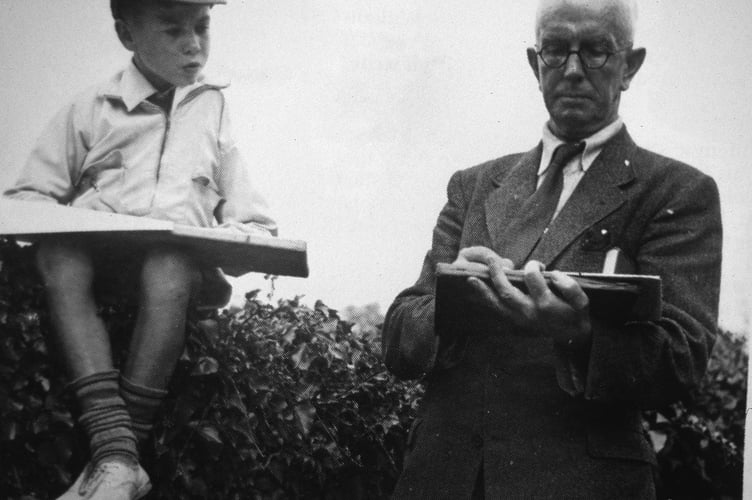In my youth I was much influenced by the artist/ historian Fred Hando, a close friend of my father, and I often accompanied them on journeys around Monmouthshire. He devoted much of his life to describing our county in great detail, with the aim of persuading his readers ‘to see the little places of a shy county, the barely known corners of this ancient land.’
One of the pictures I have included, shows me at the age of 8, (photographed by my father) in the company of Fred Hando and we are both making a drawing of a country church. His sketch was of course so much better than mine, that I decided, to take up photography instead.

Fred Hando was born in Newport in 1888, and he became a member of staff at Maindee School, where he taught art and English. During the first World War he served in France in the Royal Engineers and when he returned to Monmouthshire, after the horrors of war his eyes were opened, t the beautiful land of his birth, which he saw in a new light.
In 1921 he began to write and illustrate articles for the South Wales Argus which resulted in a total of 795 articles and seven books, which have done much to preserve the memory of ancient buildings threatened by the march of progress. He also interviewed many elderly people, who had fascinating tales to tell and legends to relate. In particular, the good farming folk who cared for our heritage, were delighted to help him record the history and folklore of Monmouthshire.
Fred wrote with a distinctive style, which was perhaps old fashioned by today’s standards, but poetic, entertaining and vividly descriptive. His work was always very readable and because his enthusiasm for everything was infectious, he undoubtedly caught the spirit of his time,
On various journeys accompanying Fred Hando and my father, I well remember how we followed leafy lanes leading to secluded hamlets, picturesquely situated in hidden valleys. We visited ancient churches, historic inns, country cottages and manor houses, which are all very special places that reflect the story of our unique county.
It was entrancing to watch Fred sketching a historic building, with deft strokes of his pencil, in order to provide a rough outline that would form the basis of a final drawing, which he would complete at home. I was just a child, but already, I was an admirer of Fred Hando. He certainly had a great influence on my life, because when I was older, I began exploring Monmouthshire on my bicycle. Reading his books and articles avidly, I took great delight in following in his footsteps. Then, later, on a few occasions I was even able to suggest locations to him that would be worthy of a visit.
Fred Hando was undoubtedly a man of many talents, for he was a teacher, a writer, an artist, a musician and a historian, who loved his county passionately. His usage of the English language was delightful, for he had the ability to paint a picture in words, with descriptions that evoked a mental image. His artistic ability enabled him to transfer a scene to his sketch pad, and the final pen and ink drawings were delightful features of his many articles and books.
Other historians sometimes accused Fred of turning legend into history, but he often wrote with his tongue in his cheek, and was just intending to preserve a record of our vanishing folklore and customs. It must be said that no writer has covered historic Monmouthshire in so much detail, for there are very few locations that he failed to visit, sketch and record.
He was particularly keen to preserve the memory of historic buildings that have now disappeared as a result of the march of so-called progress. In more than one instance, he even managed to stop the hand of destruction, and promoted the spirit of preservation, when any interesting buildings was under threat of being obliterated or unsuitably altered.

At that time, our historic watermills were disappearing at an alarming rate. For example, there were once seven mills on the Gavenny brook and forty within a radius of ten miles of Abergavenny. He wrote: “In these days of fierce competition, few of our ancient waterwheels can stay the pace. If other sources of energy are introduced into the mills, may I plead that the wheels should not be removed, but should remain part of the Monmouthshire scene.”
In 1955, details of plans for slum clearance in Abergavenny, were announced and part of the proposals included Tudor buildings in St John’s Square and Castle Street. It seems amazing now, but a respected architect and planning expert commented, that he considered these old buildings to have “nothing of historical or architectural interest.”
Writing, in 1960, Fred commented: “Standing in the archway of the Old Court, with the scarlet creeper painting the tower of St John’s Church across the open square, I wondered what lay ahead and, how this challenging area would be developed. The new look demanded now in so many of our towns, would be out of scale, out of taste, devastating, ulcer producing in Abergavenny.”
.jpeg?width=752&height=500&crop=752:500)
The ugly Post Office building which replaced the seventeenth century Old Bull Inn is an example of what was considered forward thinking at that time. How ironic , that in later years Abergavenny town centre was designated a conservation area, yet today the now closed Post Office is rated by many, the biggest eyesore in this historic town.
Edwin Cambrensis, Archbishop of Wales wrote a foreword to one of Fred’s books and commented, “His books are a delightful mixture of reminiscence, folk-lore, local history, elucidation of the meaning of place-names, and introductions to interesting people past and present, illustrated by his own careful and beautiful drawings. I believe there is a place for this kind of writing that stimulates the imagination and love for the land in which we live.”
Fred Hando wanted our county to be regarded not just as a gateway to Wales, but as a destination, for Monmouthshire at that time was generally believed by outsiders, to be a place to avoid, for it was ‘scarred by coal mines, slag heaps and factories’, which was of course not completely true
So much has changed since Fred Hando passed away. The Wye Valley has been designated an Area of ‘Outstanding Natural Beauty’; we have a World Heritage Site surrounding Blaenavon, and many Nature Reserves and Sites of Special Scientific Interest. This would most certainly have met with his approval.
Fred Hando died in 1970, ending a lifetime devoted to the county he loved and whose treasures he introduced to countless numbers of readers, far and wide, and they appreciated his work. He undoubtedly inspired me to be a writer following in his footsteps, for I too have a very high regard for the ‘Magic of Monmouthshire’.




